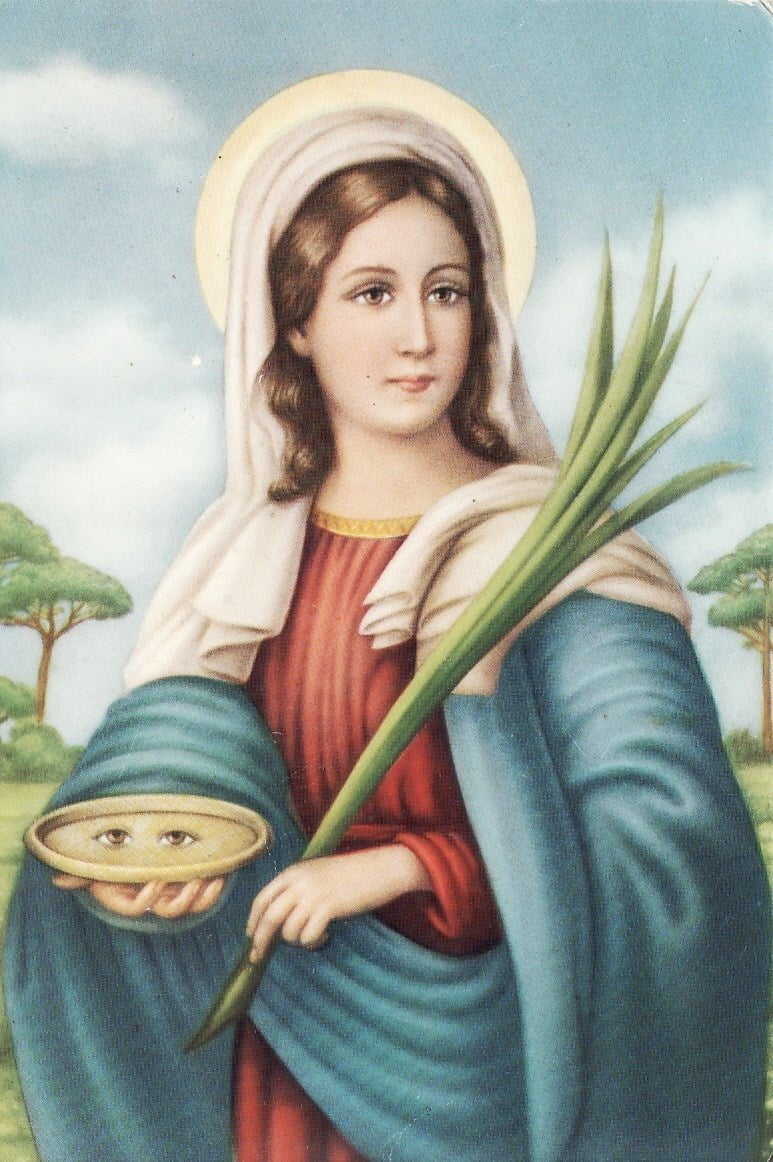Tempo di lettura: 8 minuti
Saint Lucia: Virgin and martyr (283-304)
Summary
Patroness of Syracuse
Lucia was born around the year 283 AD, in Syracuse, to a noble Christian family. Lucia's father, who was perhaps called Lucio, died when she was still very young, so she was raised by her mother Eutichia from whom she learned the truths of Christianity and the message of love from Jesus. This was how Lucia learned about the stories of the first Christians , their martyrdom for the love of Jesus and, thus growing up, in her heart, she decided to consecrate herself with a perpetual vow of virginity.
Lucia, worried about the worsening of the illness that had struck her mother, a hemorrhage considered incurable, suggested the pilgrimage to the tomb of the martyr Saint Agatha, in Catania, because the fame of the glorious saint had spread everywhere thanks to the miracles she performed operated; in her heart Lucia was certain that she too would benefit her dear mother.
Eutichia accepted Lucia's exhortation full of hope and so they decided to leave on a pilgrimage to reach Catania, where they arrived on the feast day of Saint Agatha: 5 February 301. During the celebration they heard the passage from the Gospel of Matthew concerning the story of the woman who suffered from hemorrhaging and was healed by touching Jesus' cloak. Lucia, enlightened, proposed to her mother to touch the tomb of Saint Agatha, convinced of the Saint's powerful intercession.
While Eutichia was touching the tomb, St. Agatha appeared to Lucia in a vision and told her “Lucia, my sister, why do you ask me what you yourself can obtain for your mother? Behold, your mother is already healed because of your faith".Lucia said to her mother: “Through the intercession of St. Agatha, Jesus healed you” and, thinking that this was the right moment, she revealed to her mother her intention to consecrate herself to Jesus, and to want to donate her rich wedding dowry to the poor: Eutichia agreed even if forced.
A young pagan from his city, in love with Lucia, disappointed by the failure to marry, as Lucia had explained to her that she had consecrated herself to Jesus, took revenge angrily, denouncing her, as a follower of Christ, to the terrible Roman prefect Paschasius. Emperor Diocletian had issued an edict that provided for ferocious repression against Christians.
Lucia firm as a rock
Lucia fu arrestata e condotta dinanzi al prefetto Pascasio, che le ordinò di fare sacrifici agli dei pagani per rinnegare la propria fede cristiana, ma Lucia oppose un fermo rifiuto.
Paschasius realized that he would get nothing and then ordered the girl to be taken to the worst slums of the city so that violence could be used on her. Her soldiers grabbed her to take her away, but, although she was tied hand and foot and pulled by 6 men and 6 oxen, they were unable to move her; inexplicably she Lucia remained as firm as a rock.
Paschasius thought that this miracle was a work of magic and, enraged, he ordered her to be treated like a witch: she was then sprinkled with resin and pitch and set on fire but the flames did not burn her. Lucia said to Pascasio: “I prayed to my Lord Jesus Christ so that this fire would not bother me to give believers the courage of martyrdom..."
Furious Paschasius condemned her to beheading. Before her execution, Lucia predicted the death of Diocletian, which occurred after a few years, and the end of the persecutions, which ended in 313 AD with the edict of Constantine.

Lucia killed and buried
Lucia was killed on 13 December 304 and was buried in the same place where a sanctuary dedicated to her was built in 313.
In 1039 the Byzantine general Giorgio Maniace transferred the body of St. Lucia from Syracuse to Constantinople, to remove her from the danger of invasion of the city of Syracuse by the Saracens.
In 1204, during the Fourth Crusade, the Doge of Venice, Enrico Dandolo, found the remains of the Saint in Constantinople, took them to Venice to the monastery of San Giorgio and in 1280 had them transferred to the church dedicated to her in Venice.
The sacred remains of the Syracuse saint exceptionally returned to Syracuse for 7 days in December 2004 on the occasion of the 17th centenary of her martyrdom; the arrival and departure of the remains were greeted by an incredible crowd of Syracusans hoping for a definitive return.
St. Lucia has saved Syracuse many times in its most dramatic moments such as famines, earthquakes, wars; she also intervened in other cities such as Brescia which, thanks to her intercession, was freed from a serious famine.
St. Gregory I the Great (590-604), included St. Lucia in the canon of the Roman mass. Some quotes can be found in “Summa Theologica” by St. Thomas Aquinas.
Dante makes it the symbol of enlightening Grace and defines himself as his faithful. He considered it the protector of sight and, as he says in "Banquet”, he often turned to her to heal eye problems.
Popular legend has it that the Saint's eyes were torn out of their sockets, which is why some iconographies depict the Saint with a tray in her hand on which her eyes are placed.
The life of St. Lucia, as often happens for the saints of the first centuries of Christianity, is interwoven with legendary elements; these bear witness to the enormous veneration that the saint enjoyed and enjoys both in Italy and around the world.
St. Lucia is the Patron Saint of Syracuse and many other cities in Italy and around the world: she is considered the protector of the eyes, ophthalmologists, electricians and stonemasons and is often invoked in eye diseases.

source © gospeloftheday.org
The acts of martyrdom, traditions, popular tales and legends tell its story. Lucia was born at the end of the 3rd century in Syracuse, to a wealthy, high-ranking family.
Educated in a Christian way, she was still a child when she lost her father. Raising her with love and dedication is her mother Eutichia.
Still a young girl, Lucia contemplates consecrating herself to God, but keeps her desire in her heart. Ignoring the intentions of her daughter, Eutichia, as was her custom at the time, betroths her to a young man of good family but not Christian. Lucia does not reveal that she wants to offer her virginity to Christ and she postpones the wedding under various pretexts, trusting in prayer and divine help.
The journey to Catania and the intercession of Saint Agatha
Corre l’anno 301 quando Lucia e la madre si recano in pellegrinaggio a Catania, al sepolcro di Sant’Agata. Eutichia soffriva di emorragie e, nonostante diverse e dispendiose cure, nulla le era giovato. Alla giovane martire catanese madre e figlia vogliono chiedere la grazia della guarigione.
It is February 5th when they reach the slopes of Etna, it is thedies natalis di Agata.
Partecipano alla celebrazione eucaristica presso la tomba della santa e “avvenne … che … nell’udire l’episodio evangelico dell’emorroissa, la quale aveva conseguito la guarigione al semplice tocco del lembo della veste del Signore, Lucia, rivoltasi alla madre, le disse: ‘Madre, se presterai fede alle cose che sono state lette crederai anche che Agata, la quale ha patito per Cristo, abbia libero e confidente l’accesso al Suo tribunale.
Tocca dunque fiduciosa il sepolcro di Lei, se vuoi, e sarai risanata’” (Passio di Santa Lucia). Eutichia e Lucia si accostano quindi alla sepoltura di Agata. Lucia prega per la madre e implora per sé di poter dedicare la propria vita a Dio. Assorta e presa da un soave sonno, come rapita in estasi, vede Agata tra gli angeli annunciarle: “Lucia, sorella mia e Vergine del Signore, perché chiedi a me ciò che tu stessa puoi concedere?
La tua fede è stata di grande giovamento a tua madre, essa è già guarita. E come per me è ricolma di grazie la città di Catania, così per te sarà preservata la città di Siracusa, perché il Signore Nostro Gesù Cristo ha gradito che tu abbia serbato illibata la tua verginità”.
Once Lucia wakes up, she tells her mother what has happened to her, reveals that she wants to give up an earthly husband and asks to be able to sell her dowry to give charity to the poor.
Martyrdom
Deluso e indispettito, il giovane che ambiva alla sua mano la denuncia al prefetto Pascasio accusandola di prestare culto a Cristo e di disobbedire alle norme dell’editto di Diocleziano.
Arrestata e condotta dal prefetto, Lucia, interrogata, rifiuta di sacrificare agli dei e orgogliosa professa la sua fede: “Io sono una serva dell’Eterno Iddio ed Egli ha detto: ‘Quando sarete condotti dinnanzi ai re ed ai principi non vi date pensiero del come o di ciò che dovete dire poiché non sarete voi che parlate ma lo Spirito santo è che parla in voi’”.
Domanda Pascasio: “Oh, dunque, tu credi di avere lo Spirito Santo?”. E Lucia: “L’Apostolo ha detto: ‘I casti sono tempio di Dio e lo Spirito Santo abita in essi’”. Pascasio, per screditarla, comanda allora di condurla al postribolo; Lucia dichiara che non avrebbe ceduto alla concupiscenza della carne e che qualunque violenza avesse subito il suo corpo contro la sua volontà, sarebbe rimasta casta, pura e incontaminata nello spirito e nella mente.
Prodigiosamente inamovibile, i soldati non riescono a sospingerla; legata mani e piedi, nemmeno con i buoi si riesce a trascinarla. Esasperato dallo straordinario evento Pascasio dispone che la giovane venga bruciata.
But the fire doesn't affect it. Furious Pascasio decides to have her killed by the sword. She was beheaded on December 13, 304.
source © Vatican News – Dicasterium pro Communicatione





